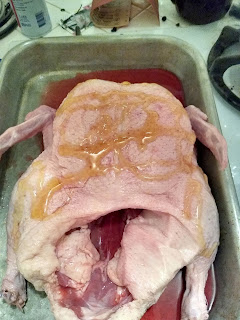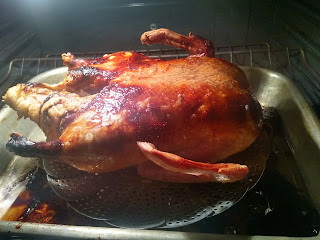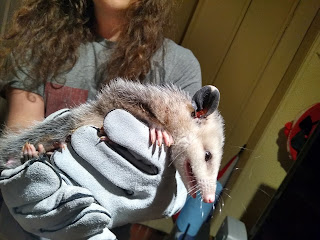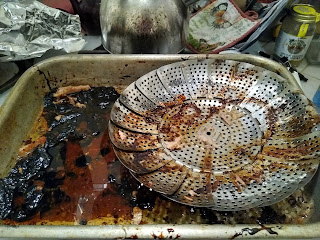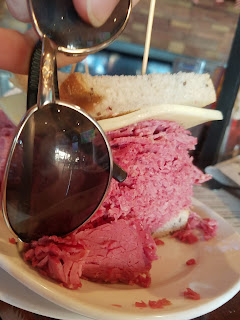"Season's greetings" is the perfect phrase for this year since nowhere in the sentence are we directed to try to be merry. Instead, we are simply greeted. Last year, Christmas was inescapable like it always is. But this year, I kept forgetting all about it and wondering why pop singers were howling their way through "Oh Holy Night" on the grocery store PA system.
In hopes of better times ahead, let's look at the merry winter travels we got to go on last year! It's like going en voyage together. Our first stop is a visit to scenic Ohio! When you reach Ohio (or at least, if you were visiting in 2019), you will note that the snow gives even the cheap fake pine garlands a festive dignity they don't inherently deserve.
We were invited to see the Rock and Roll Hall of Fame while we were in Cleveland. Apparently everyone in Cleveland gets one free admission per year (or something like that). And had I had to pay full price, I would have traipsed merrily back out the door. But before you've had a chance to see the Hall of Fame, the Hall of Fame has already seen you. The courtyard out front has a lot of these:
They of course have many famous instruments and famous costumes, but more interestingly (to me) are the bedazzled East German cars suspended from the ceiling.
They of course have hall after hall of outrageous stage costumes. In keeping with the mood, they have chosen to use mannequins with a Joel Schumacher-level attention to nipples.
 |
Headless but not titless.
|
Some of the signage at the Hall of Fame can be a bit confusing:
Like every competently-designed museum, the pathway of exhibits dumps you out at the gift shop. In theory, you will be so dazed from the many halls of wonders that you will forget that you paid $26 per person just to get in the door. If you're old enough to have at least gotten an invitation to your five-year high school reunion, you can have the horrifying realization that the clothes of your edgiest friends are now nostalgic items, sold for easily five times the price that you paid for them when you were barely old enough to drive.
Elsewhere in scenic Ohio, it seems beef is fantastically omnipresent there. Sandwiches there reach fantastic heights, as measured by my sunglasses:
That was just half of it. A sandwich in Ohio may be bigger than the upper half of your face, again shown using my sunglasses for scale. None of the friends I was visiting found anything unusual about these massive towers of dead cow that the waiter brought forth.
 |
This apparently serves one.
|
Beef is used in creative ways I've never seen elsewhere. Perhaps I should drive through the Midwest more often to see what people in the rest of the region do with all the cows they raise. I have never seen something as audacious as fried Reuben sandwich balls before. It's exactly what it sounds like: the makings of a Reuben are squeezed into spherical form, encased in rye batter, and fried. I wasn't so much surprised by the existence of this dish as how blasé everyone was at table about these. Rather than all of us gawking at this like some daring deep-fried state fair novelty, everyone found these as shocking as finding fried potatoes next to a hamburger.

You might think that perhaps we just happened to visit one of the very few restaurants that stacks meat like that. However, when ordering delivery a few nights later, the restaurant claimed that this was half of a sandwich. None of the menu descriptions said anything like "serves two" or something cute like "Hope you're really hungry" or "If you can eat it in 5 minutes it's free."
It is the same diameter as a medium pizza. Shown below is just one quarter of it. You have no doubt seen whole sandwiches of that size.
 |
I think the best proof I've gone to cooking school is that I can make plastic wrap do this.
|
|
But this is my favorite way I found that Ohioans use up all that extra beef that apparently they just can't get rid of: cheesesteak wraps!
It seems Ohio has no end of ways they will encase beef in bread dough. But perhaps one is a bit tired of restaurants. Contrary to the stereotype that everyone in the Midwest lives on canned cream of mushroom soup, Cleveland has a large Italian population. If you visiting any of them, you will soon find that you are expected to remove more than just your coat when visiting an Italian house:
Coming from a region where people think getting everyone's bare feet all over the carpet is just gross, I was not prepared to leave my shoes behind. I kept dreading that someone's dog or teething child would ruin them while I wasn't looking.
Like many Americans, I absolutely love the food at Italian restaurants and do not care that it is not at all Italian. But in an Italian home, even the non-Italian foods are different. For one thing, the store-bought ice cream looks like flowers.
Venturing back outside to help everyone with shopping, we found that one sporting goods store had not updated their display technology in quite some time. Seeing these suspended over the merchandise and blaring advertisements for canoes was downright nostalgic.
But let us now leave Ohio. If we head a little bit south, we find ourselves in Tennessee. As far as your car is concerned, you can make the drive without having to stop for gas. But culturally, you may as well stop to get your passport stamped at the border.
I'm sure the purchasers of confederate flags have been watching the trade wars with interest. Just look where they get their proud flags from.
People in the South seem to have a conflicting relationship with the
United States. Some of them can't even decide if they are US citizens or not. Many of them will fly confederate and American flags
side-by-side in their yards. The same people will declare that they are
citizens of the Confederate States of America (a country that of course
does not exist) and then buy things like this:
As you drive through the south, you may find it almost unnervingly easy to get alcohol. In some states, you cannot obtain even watered-down wine at the grocery store. In other states, you can get whiskey at gas stations.
You may remember that a few years ago, the mountains of Tennessee around the towns of Pigeon Forge and Gatlinburg suffered a devastating wildfire. While it looks like both the forest and the people have recovered, some people have chosen to display signs of fire damage like trophies of survival.
You don't have to go far from a town before getting the two biggest signs that you are in the country. First, your phone reception does this:
 |
I know people drove through remote areas long before we had cell phones. They also got stranded and died.
|
Second, you find people locking up the trash from the wildlife like you're camping instead of a house.
Tourist center brochures, signs at hotels, and signs on the road alternately beg and command you to not to feed the bears. It is impossible to drive through the mountains of Tennessee without seeing the slogan "A fed bear is a dead bear," usually in all capitals. If you're a bit wary of being so far from civilization, you can look out the window and be amazed at how beautiful and green it is outside. The air smells like a forest (because you're in one) and feels so nice on your face.
 |
The camera is not crooked; the mountains really are tilted like that.
|
There were many attractions we could have seen in the town of Pigeon Forge. Dinner theater is a popular attraction there. The actual food of the dinner theater seems to be a secondary concern to the theatrics. Whether you're going to see medieval jousting, pirates, a recreation of the Hatfield-McCoy feud, a Motown tribute, or anything else, the menus are all a variation of mashed potatoes, corn with extra butter, biscuits, and meat with gravy on top. But one beat-up building grabbed our interest more than the thrilling exhibitions that tantalize tourists:
We barely passed through the door before seeing perhaps the most aggressively American merchandise:
Elsewhere in the store, all the late-night informercial favorites could be had. There were sketchy cosmetics that probably would give you dreadful skin reactions:
Tweety merchandise that seemed to reach us straight from the mid-90s:
Clothes for men who are desperately trying to prove how tough and manly they are:
Knife sets (when you've been awake long enough, those late-night knife demonstrations are mesmerizing enough to make you not want but need an onion spiralizer):
Knockoffs of popular trends, barely renamed enough to avoid copyright charges:
And lots of pocket-size gadgets that probably will quickly fall apart, but are nevertheless an amusing way to spend a relatively harmless amount of money.
But now, let us leave the eastern half of the United States and journey to the very center of it. Our vehicle is now in scenic Nebraska, home of a lot of cornfields and Arbor Day. You know you won't go hungry in Nebraska as soon as you go to the grocery store. Most places sell candy bars and other single-serving delights near the cash register. In Nebraska you can toss a full-size package of Oreos in your cart while you're waiting for the cashier to ring up the person in front of you.
Nebraska elevates the "convenience" in "convenience foods" to an art. Have you ever wanted to munch on chocolate chip cookies while driving, but found the cookies too difficult to hold while steering?
Have you ever wished your hot breakfast came in pizza form so you could skip using a fork?
Moving away from gas station comestibles, we find Nebraskan restaurants will serve all manner of edible delights... often after frying them. Where I am from, deep-fried Oreos are a novelty you find at festivals. People take selfies while eating them just to prove that deep-fried Oreos exist. In Nebraska, you just order them with your cheeseburger.

Our friends in Nebraska insisted on taking us to see historic architecture. Most people will look at fantastic wall carvings or the amazing glasswork, and we did find a lot of it beautiful. But we were especially fascinated to find one building still had its original gas-and-electric lights. These come from a very specific time in history, when electric lights were finally available, but electricity was still so unreliable (and often shut down at night) so people still had gas lights in their house. For about 15 years, the modern choice was to put both the reliable but old-fashioned gas light and the modern but undependable electric bulb in the same fixture. You can recognize the former gas light by the air holes under the flame, and also by the fact that the top is open-- because a flame would be in there.
Our roadtrip now takes out of Nebraska and directly south. What will we find as we cross the state line and enter Kansas?
We will find a lot of fog. Almost as soon as we entered Kansas, we drove into what seemed like a wall of fog and couldn't see anything else. On the bright side, if you must pull over in Kansas, you will find the bathrooms are dingy but very well-cleaned. They even have convenient waiting benches. It may seem silly to have benches in the bathroom, but it will make sense if you've ever roadtripped with friends when it was too cold to wait outside while everyone answered the call of nature.
Departing Kansas, we enter the state of Oklahoma. If you didn't know gambling is legal in Oklahoma, you find out as soon as you make a pit stop.
Even the tiny picnic areas have charming details. After being in the car for so long, you may be fascinated by the miniature trash cans wearing adorable brown derby hats, suspended from poles and swinging in the gentle breeze.
But at last, we reached the end of our great cross-state trip. We find ourselves in Texas. When you visit Texas, you find that Texans are peculiarly proud of being Texan. Many people in the state are Texans first and Americans second. A lot of people, regardless of how deep into the city they may live, tend to select their vehicles as if they're only temporarily in town and will move out to the country very soon. Large trucks populate the parking lots of grocery stores and strip malls, as if the owners are going off-roading and buying building supplies on the way home. Even the signage in shopping malls reminds you that you are in Texas.

Texas is the only state in all of America where I have seen actual legal notices about guns in extra-large letters at the entryways to otherwise boring office buildings.
Also in Texas, we find that deep-frying is considered a matter of state pride. Every year, at least two thirds of state fair news is a loving tribute to everything that enterprising food vendors will immerse in boiling fat. It is a strange, greasy combination of food and performance art. Even in gas stations, you will find that they're not just frying potatoes and sausages.
In case your deep fried pizza makes you thirsty, you can obliterate it with a quart of soda. For all my metric friends, that's about half a deciliter short of a liter. You know I had to investigate this one. Sure enough, deep-fried brown triangles sat already-wrapped and drying out under the heat lamps next to the (also fried) burritos.
I thought this was a peculiar offering of one particular convenience store somewhere on a particularly uninhabited section of the interstate, but they turned up again.
 |
Note that the wrapper specifies "pepperoni," implying that connoisseurs of fried pizza can select the flavor that brings them the most happiness.
|
Everyone in the car agreed that if one person tried to eat it, they would surely know internal regret. Yet we were all mystified and beguiled by the mysterious deep-fried pizza. After much deliberation, we agreed that none of us would get an instantaneous heart attack if we purchased one and passed it around. The deep-fried pizza was anticlimactic. I had imagined they literally took a slice of pizza, dipped it in batter, and fried it. It was really more of a fried triangular Hot Pocket.
I think I'm going to have to stop being astonished at fried foods in America. To tell the truth, I was never shocked at finding that every edible substance has been battered and immersed in hot oil somewhere in this great country. I'm more surprised at how normal this is. You don't see people at restaurants waving menus at their friends, pointing, and saying "Can you believe that they have fried beef jerky?"
To end on a festive note, let's look at the cutest bathroom I ever washed my hands in during the entire holiday season last year.

And so, from all of us at A Book of Cookrye to you...





















